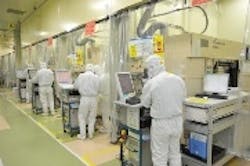Gigaphoton develops laser for high-output EUV light sources
Oyama-shi, Tochigi-ken, Japan - Gigaphoton Inc., a major lithography light source manufacturer, has jointly developed a high power CO2 drive laser for extreme ultraviolet (EUV) light sources with Mitsubishi Electric Corp., a manufacturer of electrical and electronic equipment. Also, an average output level of 15 W was achieved on a development EUV system, representing another step forward in realizing production level EUV light sources.
The 15 W EUV light output was confirmed on a prototype EUV light source. Furthermore, initial experiments conducted on the jointly developed CO2 drive laser have produced output power of over 20 kW, signifying that a key piece of technology necessary for producing EUV output levels of 250 W which is necessary for high volume manufacturing (HVM) has been realized.
Gigaphoton has focused on developing high output, stable, and economical LPP light sources since 2002. During that time, Gigaphoton has introduced several unique technologies that have received industry-wide attention. The recent achievements can be attributed to Gigaphoton's highly advanced technical capabilities, bringing the company one step closer to achieving mass production of LPP light sources.
Tin (Sn) droplets are irradiated using a high-energy pulse driver laser to create tin plasma which is used to generate the EUV light. Improving the conversion efficiency of the EUV light generation and achieving efficient and effective mitigation of debris from the collector mirror are key issues that must be resolved for production level EUV light sources.
Highly efficient EUV output is possible through Gigaphoton's technology based on the optimized use of a short wavelength solid-state pre-pulse laser in conjunction with a CO2 main pulse laser. Efficient and effective debris mitigation is also possible through Gigaphoton's method of utilizing a superconducting magnet to generate a powerful magnetic field that guides the unwanted debris resulting from the thermal expansion of the tin droplets towards the tin catcher. This results in further reduction of cost and downtime.
____
Photo:
Gigaphoton’s laser light sources are manufactured at its state-of-the-art Oyama factory, on the premises of its headquarters.
